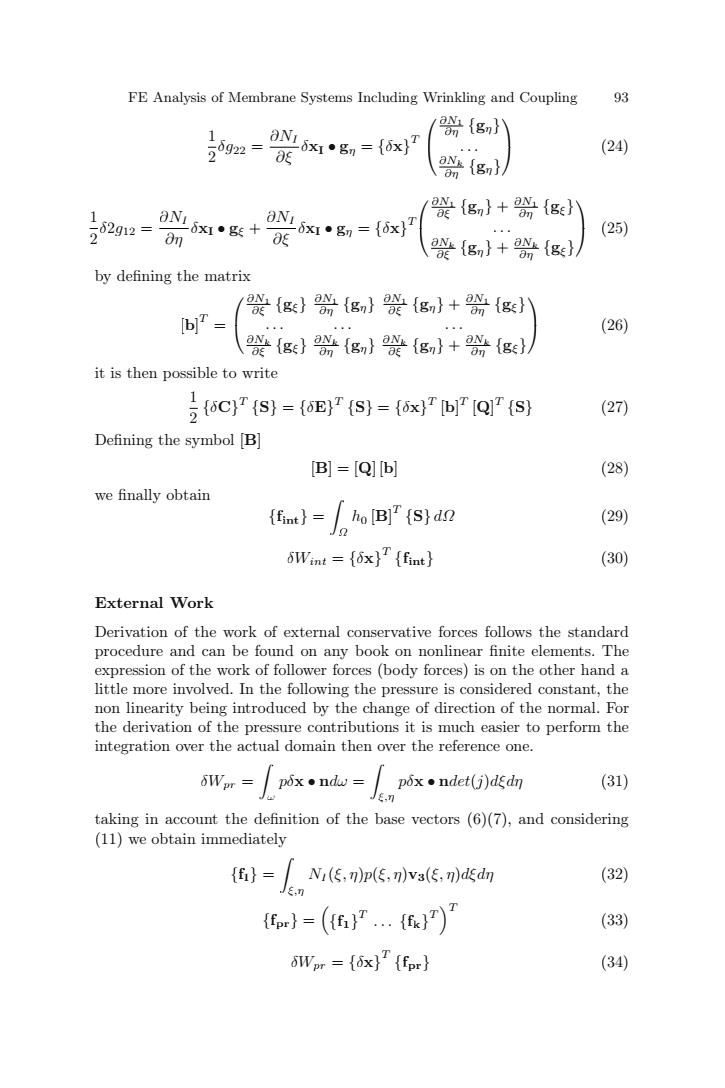正在加载图片...

FE Analysis of Membrane Systems Including Wrinkling and Coupling 93 ga-21·8=刘 {g} (24) ON (gn) 202g12= Nx灯·g<+0c Nx·g={6x {g}+盼{ge) (25) on 股{g}+册{8<} by defining the matrix /器{g}器{g}器{g}+器{g} [b)T (26) 驶{g<}{g}{g}+{g} it is then possible to write acy7s)=EΨs=7rQrs (27) Defining the symbol B] [B]=[Q][b] (28) we finally obtain (fint}=ho [B]T (S)do (29) 6Wint={ox){fint} (30) External Work Derivation of the work of external conservative forces follows the standard procedure and can be found on any book on nonlinear finite elements.The expression of the work of follower forces (body forces)is on the other hand a little more involved.In the following the pressure is considered constant,the non linearity being introduced by the change of direction of the normal.For the derivation of the pressure contributions it is much easier to perform the integration over the actual domain then over the reference one. 6Wor p6x.nd p6x.ndet(j)dedn (31) taking in account the definition of the base vectors (6)(7),and considering (11)we obtain immediately }= Ni(,m)p(ξ,jv3(5,n)dd (32) }=(《6}T.…{.}T) (33) 6Wpr ={6x}(fpr} (34)FE Analysis of Membrane Systems Including Wrinkling and Coupling 93 1 2 δg22 = ∂NI ∂ξ δxI • gη = {δx} T ⎛ ⎝ ∂N1 ∂η {gη} ... ∂Nk ∂η {gη} ⎞ ⎠ (24) 1 2 δ2g12 = ∂NI ∂η δxI • gξ + ∂NI ∂ξ δxI • gη = {δx}T ⎛ ⎝ ∂N1 ∂ξ {gη} + ∂N1 ∂η {gξ} ... ∂Nk ∂ξ {gη} + ∂Nk ∂η {gξ} ⎞ ⎠ (25) by defining the matrix [b] T = ⎛ ⎝ ∂N1 ∂ξ {gξ} ∂N1 ∂η {gη} ∂N1 ∂ξ {gη} + ∂N1 ∂η {gξ} ... ... ... ∂Nk ∂ξ {gξ} ∂Nk ∂η {gη} ∂Nk ∂ξ {gη} + ∂Nk ∂η {gξ} ⎞ ⎠ (26) it is then possible to write 1 2 {δC}T {S} = {δE}T {S} = {δx}T [b] T [Q] T {S} (27) Defining the symbol [B] [B] = [Q] [b] (28) we finally obtain {fint} = Ω h0 [B] T {S} dΩ (29) δWint = {δx} T {fint} (30) External Work Derivation of the work of external conservative forces follows the standard procedure and can be found on any book on nonlinear finite elements. The expression of the work of follower forces (body forces) is on the other hand a little more involved. In the following the pressure is considered constant, the non linearity being introduced by the change of direction of the normal. For the derivation of the pressure contributions it is much easier to perform the integration over the actual domain then over the reference one. δWpr = ω pδx • ndω = ξ,η pδx • ndet(j)dξdη (31) taking in account the definition of the base vectors (6)(7), and considering (11) we obtain immediately {fI} = ξ,η NI (ξ, η)p(ξ, η)v3(ξ, η)dξdη (32) {fpr} = {f1}T . . . {fk}T T (33) δWpr = {δx} T {fpr} (34)